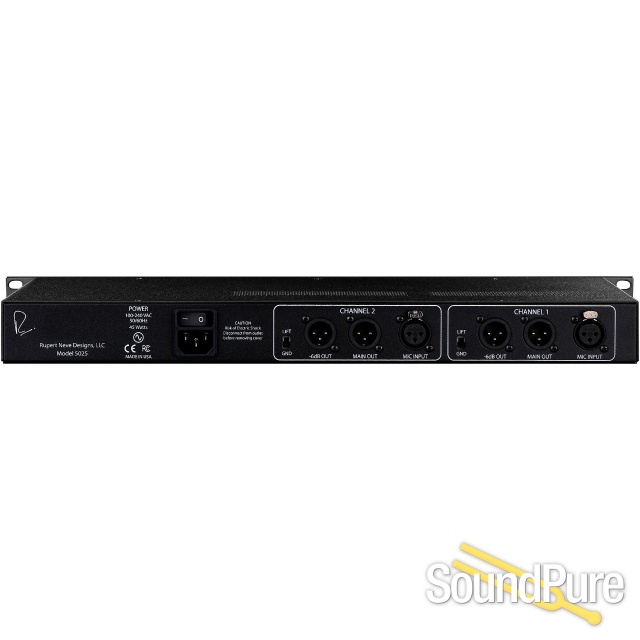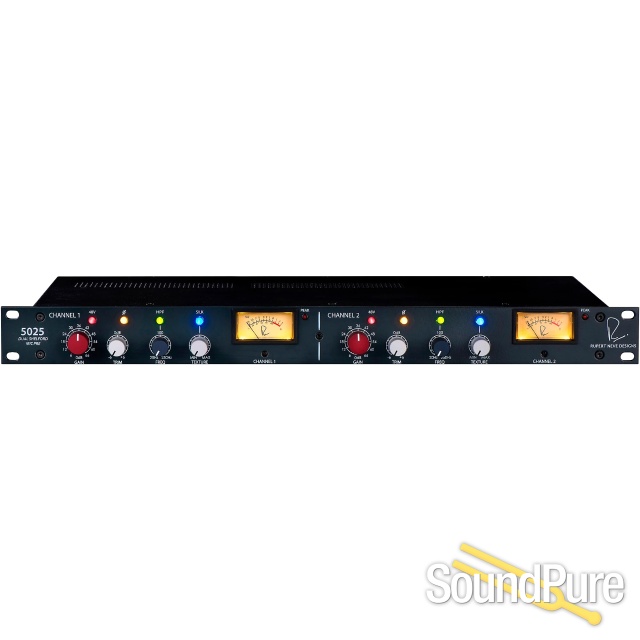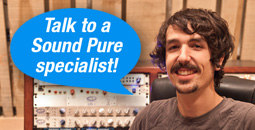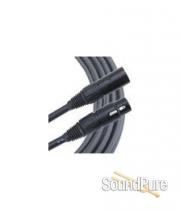-
Call Us Toll Free888-528-9703
-
Local/International (+1)919-682-5552
- Call Us! Toll Free! 888-528-9703
- Local / International (+1) 919-682-5552

Rupert Neve Designs Preamp and Compressor Bundle From Neve
Two channels of world class mic preamps combined with two channels of iconic diod bridge compression.
$6,998.00
"Experience the Difference"
 Payments as low as $159/mo.
Payments as low as $159/mo.
Manufacturer's Description from Neve
This bundle combines two iconic sounds in the Rupert Neve Designs catalog: The 5025 Shelford Dual Mic Preamp and the 5254 Shelford Diode Bridge Compressor.
Our best-selling Shelford Channel is the definitive evolution of the original technologies in Rupert’s classic modules like the 1073, 1064 & 2254, thoughtfully advanced and refined for the 21st century studio.
By popular demand, we are now offering the Dual Shelford Mic Pre: a two-channel version of our flagship preamplifier that has become an indispensable tool for countless engineers and musicians. The Dual Shelford offers the sonic excellence of two Rupert Neve Designs Shelford mic preamps in a single rack space with an internal power supply; simply put, these are two channels of the finest microphone preamplification in the world.
The Transformer Gain Mic Pre
Like Rupert’s designs from his time in Little Shelford, the Dual Shelford Pre uses a custom step-up transformer on the microphone input that provides the first 15 dB of gain. This specially-designed transformer, along with its careful integration with the surrounding class-A circuitry, is critical to the amplifier’s bold, mid-focused magic that can be heard on thousands of classic recordings.
While the majority of the harmonic richness found in Rupert’s designs is a product of the output transformer and surrounding class-A amplifiers, this step-up input transformer also imparts a unique musical enhancement of its own. The technical reasons for this are primarily a result of the reactive impedance characteristic of the input transformer and how that interacts with the connected microphone, resulting in subtle, non-linear harmonic enhancement of the lows and an unmistakable sweetness in the high frequencies.
While creating the input stage for the Shelford Channel and Dual Shelford Pre, the goal was not merely to recreate the classic designs, but to advance them: combining the unmistakable sound of the vintage technology with wide-bandwidth frequency response, consistently excellent amplifier performance at any gain setting, and extremely low noise operation.
To achieve this, the custom transformer designs were carefully optimized and complete MuMetal shielding of the input transformer was implemented. The resulting preamplifier is flat from below 10Hz to above 60kHz, resulting in the purest possible tone and the very highest levels of versatility.
The Dual Output Level Transformers
Complementing the Silk circuit are the custom-designed output transformers, which use Rupert Neve Designs’ distinctive dual output topology. These offer both Main (+26 dBu) and -6dB (+20 dBu) outputs, allowing the engineer to drive the preamps fully into classic transformer saturation without clipping converters and other devices later in the chain.
The main outputs are designed to capture a more pristine sound at high levels, avoiding any nonlinear coloration of the output stage. The -6dB outputs allow an engineer to fully drive the Shelford – adding dynamic tone with these same nonlinear “colorations” – without clipping most professional interfaces. On drums, vocals, guitars and other instruments, these outputs let you easily hit the transformer’s “sweet spot” of nonlinear harmonic content, bringing a recorded performance to life in a way that other preamps simply cannot match.
Mic Gain
This 12-way precision rotary switch controls gain from 0 to 66 dB in 6 dB steps.
Trim
This rotary switch provides further continuous gain adjustment over a range of +/– 6 dB.
48V
This push button switch engages phantom power on the microphone input.
Polarity
This push button switch inverts the polarity of the signal path. It illuminates when engaged. (The symbol “Ø” is often used to denote opposite polarity.)
HPF / HPF FREQ
The HPF switch engages a 12dB per octave high pass filter. The HPF FREQ potentiometer is variable from 20Hz to 250Hz, and can be used to filter out unwanted low frequencies, or in conjunction with the EQ to help shape source material. Note that engaging the HPF to S/C switch moves the HPF from the primary signal path to the compressor side-chain signal path.
Silk / Texture
Pushing the Silk button cycles the Silk modes from Red to Blue to OFF. Silk reduces the negative feedback on the output transformer, adding harmonic content as the texture is increased. Red Silk accentuates the musical harmonic saturation from the mid and high frequencies, while Blue Silk accentuates harmonics from the low and low-mid frequencies. By manipulating the Texture control, the amount of Silk can be changed from essentially absent, to roughly 4-5% THD (mostly second order) depending on how hard the output transformer is being driven.
VU Meters
The VU Meters are calibrated to display average (RMS) output levels.
Peak LED
Red indicates near clipping of the output stage.
Dual Tap Output
In addition to the MAIN full-headroom output, the -6dB output creates a rich harmonic character while reducing the risk of clipping the next device in the chain.
Gnd Lift
This switch separates the direct connection from audio signal ground to chassis earth.
Universal IEC Power Input
Works worldwide, accepting voltages from 100-240VAC.
Since the early 1970s, Rupert Neve’s early diode bridge compressors have been revered for the punch & glue they bring to drums, instruments, and the mix buss – but these desirable characteristics were unfortunately accompanied by inflexible controls and fairly limited versatility. Rupert Neve Designs created the 5254 Dual Diode Bridge Compressor to capture the soul of these coveted compressors while providing modern updates including advanced timing control, significantly lower noise, fully stepped controls throughout, higher voltage power rails, and internal parallel processing capabilities.
Unlike our VCA compressors, which are built for exacting clarity, the harmonically rich tonality of the Dual Diode Bridge Compressor is built to produce a wide range of colors – and built to help you make a statement with your music. Based on the dynamics circuit originally developed for the acclaimed Shelford Channel, the 5254 is outfitted for dual mono or stereo use with Rupert Neve Designs’ custom transformers and class-A electronics, tailor made for a compact 1U 19” enclosure.
Fifty years after Mr. Rupert Neve created his first compressor designs, the Dual Diode Bridge Compressor reimagines the larger-than-life personality of these classic circuits with new levels of precision and control, enhanced creative power, and increased punch to your tracks, mixes, and masters.
The Diode Bridge
Where the VCA compressor found in the Portico II Channel and Master Buss Processor provides unmatched clarity, the weighty, harmonically rich tonality of diode bridge compression can be essential in pushing key sources like vocals, electric guitars, bass and drums to the forefront of a mix. By understanding the limitations of the vintage units’ topologies, painstaking effort was taken to reproduce the unique tone of these classics while improving the noise floor, expanding inflexible time constants, adding full wave sidechain detection for improved dynamic response, and widening the range of threshold and ratio controls. Delivering the powerful sound of these iconic designs with enhanced flexibility for the modern age, the Dual Diode Bridge Compressor is a dynamic tool equipped to make a bold statement on virtually any mix or track.
Timing is Everything
The unified TIMING control consists of six selectable settings, carefully chosen for different applications – a major departure from the slow, fixed attack of the vintage units. FAST and MF settings are designed to help clamp down on more transient signals like drums, plucked string instruments and fast vocals. MED and MS have slightly slower attacks and releases which allow more transients through, while having a slightly longer recovery. Lastly, SLOW and AUTO are both significantly slower and feature complex nonlinear release times, with smoother, less audible level control.
FAST mode increases the speed of both the attack and release for each setting, also effectively doubling the number of time constants from 6 to 12. The FAST mode also allows for a dramatic increase in speed as compared to the Dual Diode Bridge Compressor’s renowned ancestors, providing significantly more tonal & operational versatility.
Faster TIMING settings will generally lead to higher peak-to-peak control voltage ripple, and therefore induce more harmonic content, translating into more color in the main audio path. Slower TIMING settings will smooth the control voltage significantly, and thereby reduce the harmonic content added to the audio path, resulting in more transparent compression. It is also worth noting that due to the nature of this topology, these time constants inherently adapt themselves slightly depending on several factors: compression ratio, threshold, and source material. This dynamically generated timing shift and harmonic content is what gives the Dual Diode Bridge Compressor its unique personality.
The Right Blend
Given the naturally colored sonic signature of the 5254’s diode bridge, this built-in parallel compression ability is especially useful. The BLEND control allows the user to inject smaller amounts of extreme compression into an otherwise unaffected signal, creating an enhanced yet natural sound that maintains dynamic range with blendable color and punch.
Take Control
In addition to the TIMING control, the diode bridge compressor can be further manipulated by the RATIO, THRESHOLD, GAIN, S/C HPF, S/C INSERT and LINK controls. The RATIO control has six selectable positions on the rotary switch and allows the user to set the slope of the compressor curve with ratios of 1.5:1 through 8:1. The THRESHOLD control allows the user to adjust the point at which compression begins, ranging from -25dBu to +20dBu. The GAIN control adds make-up gain ranging from -6dB to +20dB. The S/C HPF is 12dB/octave with continuously variable frequency control from 20Hz to 250Hz. This feature can be immensely useful for making the compressor respond less to the powerful – and often more sustaining – low frequencies in a mix or instrument, which might otherwise give the compressor a more “mushy” response. The SC INSERT is comprised of an always-active send and return for the compressor side chain, which can be used to insert a more fine-tunable EQ to further sculpt the compressor response, or as a way to insert a key signal into the return, controlling the compression via a separate source to “duck” the signal when the key source is above the threshold. LINK connects the control voltage between the two channels – so when one channel is triggered, it will trigger the other channel equally. This can often help maintain a solid center image in a stereo source. Note: for stereo sources, it is always worth auditioning the “unlinked” sound as well, as linking can sometimes clamp down on the effective stereo width when the compressors are triggered by one side.
FEATURES
◆ Classic Diode Bridge Tone
◆ Capture the punchy, larger-than-life tone used on countless hit records for the last 50 years.
◆ Advanced timing controls
◆ Custom-shape your compression envelope with the unified timing control, which enables a much wider range of responses than vintage units or clones.
◆ Custom Transformers and Class-A Line Amplifiers
◆ Vintage warmth meets the improved headroom and precision of Rupert Neve’s updated transformer-coupled line stages.
◆ 31-Position Detented Controls
◆ Accurately recall and match your settings with precision and speed.
◆ Built-In Parallel Compression
◆ Internal blend control enables you to subtly dial in more dramatic compression settings for color as desired.
◆ Full-Wave Sidechain Detection
◆ Enhanced from the vintage units’ half-wave design, the updated sidechain detector provides substantially more accuracy.
◆ Stereo Linking
◆ Run your compressors in either dual mono or stereo configurations.
◆ Internal Universal Power Supply
◆ EIC connection for world-wide AC power from 90-240V embedded in the 1U rack-mountable chassis.

About Manufacturer
Specifications
XLR Line Input to XLR Line Output (Compressor Bypassed) ZSOURCE= 40 Ω Balanced
Input Impedance: 10 kΩ
Output Impedance: 40 Ω
Maximum Input Level (+4dBu Selected): +26.7 dBu typical
Maximum Output Level: +26.7 dBu typical
Noise (22 Hz - 22 kHz BW): -104 dBu typical
Frequency Response (10 Hz to 120 kHz): +/- 0.25 dB typical
THD+N @1 kHz @ Maximum Level (22 Hz - 22 kHz BW): 0.0008% typical
Compressor Noise Specifications
Noise @ 0dB Make-Up Gain (22 Hz - 22 kHz BW): -84.5 dBu typical
Noise @ +20dB Make-Up Gain (22 Hz - 22 kHz BW): -64.5 dBu typical
Compressor Timing Specifications
Note: TIMING measurements represent the full range achievable between 1.5:1 and 8:1 ratio and FAST mode
FAST
MF (MEDIUM FAST) MED (MEDIUM)
MS (MEDIUM SLOW) SLOW
AUTO
Attack 250μS - 2 mS // Release 100mS - 200mS typical Attack 1mS - 5mS // Release 100mS - 200mS typical
Attack 3mS - 18mS // Release 350mS - 700mS typical Attack 5mS - 40mS // Release 600mS - 1S typical
Attack 10mS - 80 mS // Release 800mS - 1.5S typical
Attack 5mS - 40mS // Release T1 400-900mS, T2 1-2S typical
WEIGHTS & DIMENSIONS
Product Dimensions (W x D x H): 19” (48.3 cm) x 8.25” (20.9 cm) x 1.65” (4.2 cm)
Shipping Dimensions (L x W x H): 24” (61 cm) x 13” (33 cm) x 4” (10.2 cm)
Shipping Weight: 10 lbs. (4.5 kg)


















